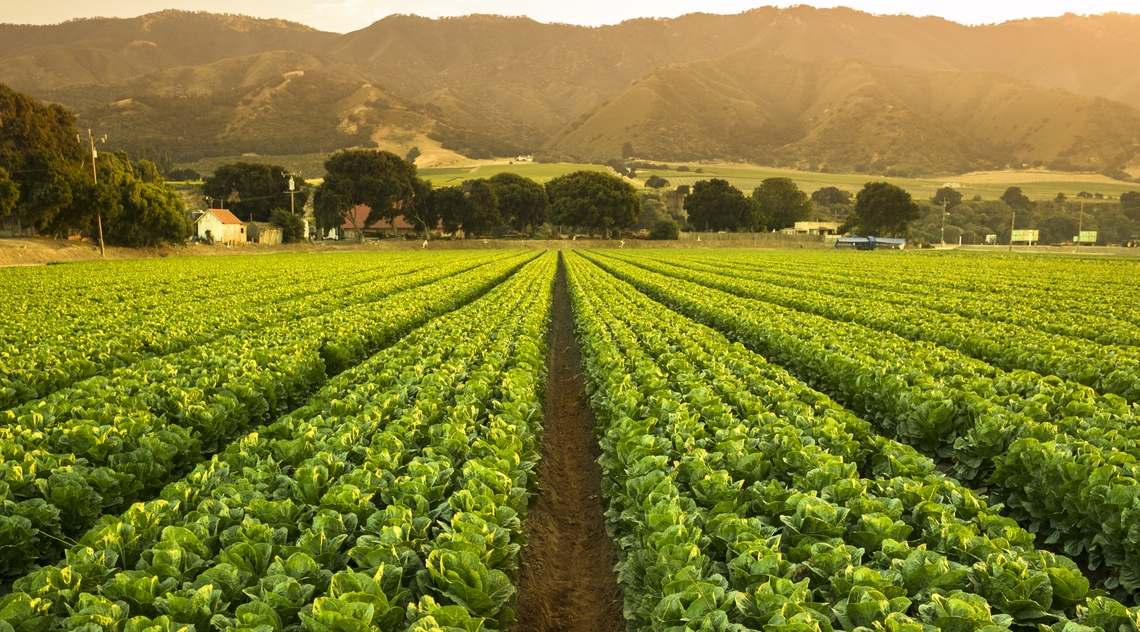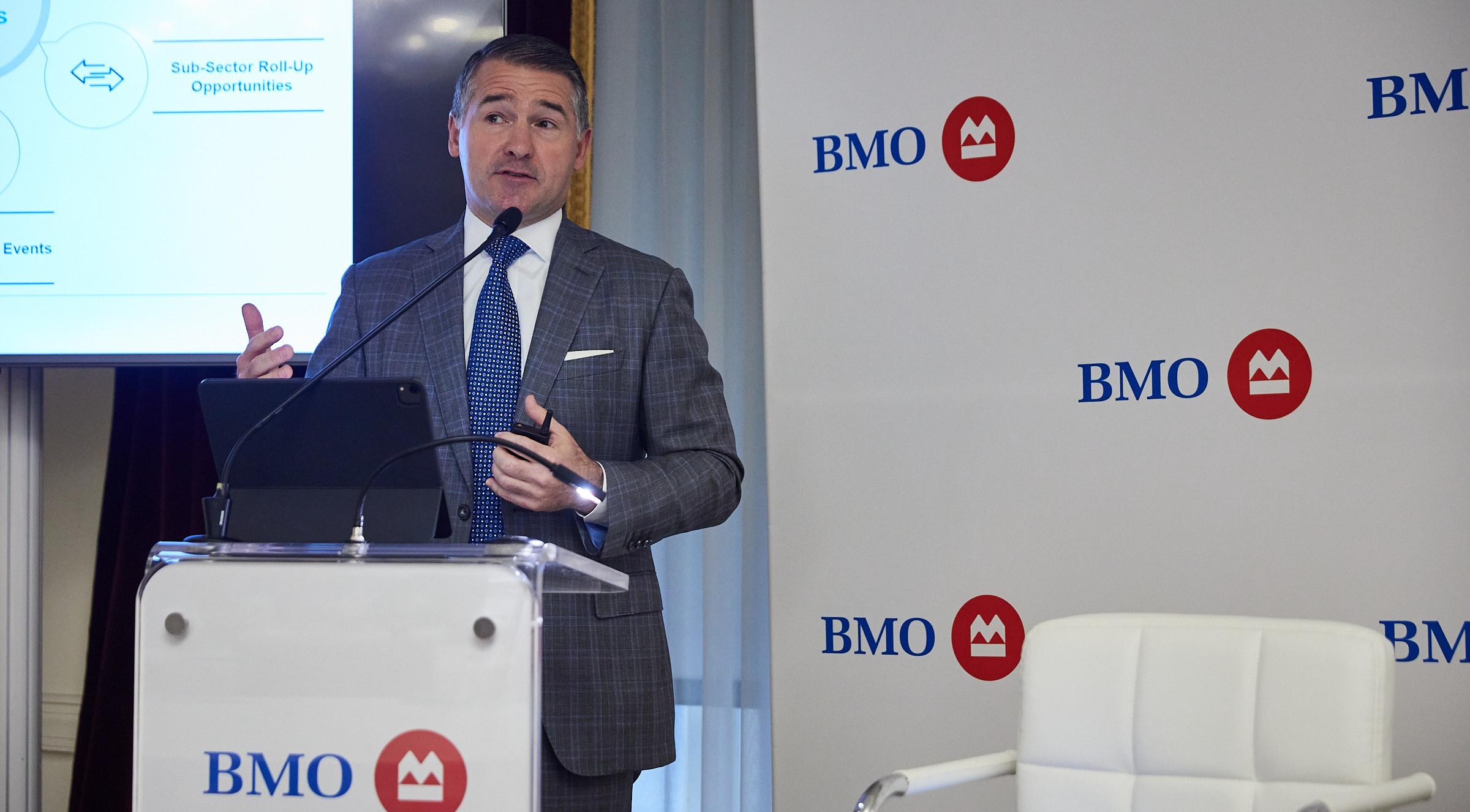
Exploring the Physical and Transition Risks Facing Food and Agriculture
-
bookmark
-
print

- Keywords:
- farm to market
- food & beverage


No major industry has as much at stake in how humanity responds to climate change as agriculture. “It is both a source of greenhouse gas emissions and a sink for greenhouse gas emissions,” Doug Morrow, director and research analyst, ESG Strategy, for BMO Capital Markets, told the 17th annual BMO Global Farm to Market Conference in New York.
In other words, the agriculture sector has a lot of work to do to reduce its carbon intensity, but it also has a lot to lose if the global energy transition fails. “The lesson I want to pass on is that climate change represents a genuine risk to agriculture and food production going forward, and by extension to food companies and farmers,” he said during his presentation, Exploring the Physical and Transition Risks Facing Food and Agriculture.
Mitigating Rising Emissions
Agriculture, forestry, and other land uses account for just under a quarter of all greenhouse gas emissions, according to Intergovernmental Panel on Climate Change (IPCC) statistics. While about 25% of those emissions can be attributed to food production, deforestation for the creation of farmland, livestock raising, fertilizers, emissions from farm equipment and food waste are also significant sources of carbon dioxide emissions.
Fortunately, sustainable farming techniques, such as cover crops, low/no-till cultivation and diverse crop rotations, can mitigate farming-related emissions, Morrow said, and policies to protect forests and behavioural modifications to change people’s diets also hold potential.
The sector, however, has been slower than other sectors to adopt the kind of innovations it needs to mitigate climate change.
“The challenge within these solutions is that they need to be balanced against many other priorities, including the livelihood of farmers and farm communities [as well as] food security,” Morrow explained. That’s “we haven’t really seen the type of breakthroughs and widespread adoption we’ve seen in other sectors,” such as in the explosive growth of solar and wind power, electric vehicles, and green buildings, he said.
That could change, with more capital being directed into agricultural technology, including the recently launched 300-million-euro private equity fund dedicated to regenerative agriculture by Unilever, French insurer AXA and alternative asset manager Tikehau Capital.
Climate change represents a “two-way street” for farmers, though. “The physical impacts of climate could have a significant negative impact on agriculture and food production in the future,” Morrow said. Another IPCC report indicated that “the buildup of CO2 in the atmosphere is already negatively affecting food systems, animal health and food availability,” he continued. The impact may be manageable if emissions stick to the 1.5-degree global average temperature increase outlined in the Paris Agreement, but “we are not close at all” to achieving that goal, he noted.
“Based on policies that have been implemented as of today, we are heading for an estimated 2.7 degrees of warming by the end of the century,” he noted. Even if countries enact more significant emissions controls, there’s a substantial gap between where the world is going and where it needs to be by 2050. “What this means is that we are likely headed towards a future that is going to be much warmer than any of us are historically used to,” he concluded.
Increased Reporting
One measure that could have a major impact on public companies in agri-food is a U.S. Securities Exchange Commission proposal requiring issuers to disclose various climate-related metrics and risks. For example, companies would have to report their Scope 1 (direct) and Scope 2 (indirect, for example from the electricity supplied by their local utility) emissions, verified by a third party, in addition to Scope 3 emissions arising from other indirect impacts of business activity, such as customers’ use of their products or services and suppliers’ emissions.
The proposal will have significant costs, the SEC allows, but investors will for a change have easily accessible and comparable information “on an issue that is arguably only going to become more important over time,” Morrow said. For this reason, it’s important that companies get a head start on climate-related reporting and involve management at the highest levels.
“The main message here is that food and ag is a contributor to climate change, but it’s also significantly exposed to the risks that climate change is triggering,” Morrow said. “I also believe investor interest in sustainable agriculture is going to become much more important over time.”
No major industry has as much at stake in how humanity responds to climate change as agriculture. “It is both a source of greenhouse gas emissions and a sink for greenhouse gas emissions,” Doug Morrow, director and research analyst, ESG Strategy, for BMO Capital Markets, told the 17th annual BMO Global Farm to Market Conference in New York.
In other words, the agriculture sector has a lot of work to do to reduce its carbon intensity, but it also has a lot to lose if the global energy transition fails. “The lesson I want to pass on is that climate change represents a genuine risk to agriculture and food production going forward, and by extension to food companies and farmers,” he said during his presentation, Exploring the Physical and Transition Risks Facing Food and Agriculture.
Mitigating Rising Emissions
Agriculture, forestry, and other land uses account for just under a quarter of all greenhouse gas emissions, according to Intergovernmental Panel on Climate Change (IPCC) statistics. While about 25% of those emissions can be attributed to food production, deforestation for the creation of farmland, livestock raising, fertilizers, emissions from farm equipment and food waste are also significant sources of carbon dioxide emissions.
Fortunately, sustainable farming techniques, such as cover crops, low/no-till cultivation and diverse crop rotations, can mitigate farming-related emissions, Morrow said, and policies to protect forests and behavioural modifications to change people’s diets also hold potential.
The sector, however, has been slower than other sectors to adopt the kind of innovations it needs to mitigate climate change.
“The challenge within these solutions is that they need to be balanced against many other priorities, including the livelihood of farmers and farm communities [as well as] food security,” Morrow explained. That’s “we haven’t really seen the type of breakthroughs and widespread adoption we’ve seen in other sectors,” such as in the explosive growth of solar and wind power, electric vehicles, and green buildings, he said.
That could change, with more capital being directed into agricultural technology, including the recently launched 300-million-euro private equity fund dedicated to regenerative agriculture by Unilever, French insurer AXA and alternative asset manager Tikehau Capital.
Climate change represents a “two-way street” for farmers, though. “The physical impacts of climate could have a significant negative impact on agriculture and food production in the future,” Morrow said. Another IPCC report indicated that “the buildup of CO2 in the atmosphere is already negatively affecting food systems, animal health and food availability,” he continued. The impact may be manageable if emissions stick to the 1.5-degree global average temperature increase outlined in the Paris Agreement, but “we are not close at all” to achieving that goal, he noted.
“Based on policies that have been implemented as of today, we are heading for an estimated 2.7 degrees of warming by the end of the century,” he noted. Even if countries enact more significant emissions controls, there’s a substantial gap between where the world is going and where it needs to be by 2050. “What this means is that we are likely headed towards a future that is going to be much warmer than any of us are historically used to,” he concluded.
Increased Reporting
One measure that could have a major impact on public companies in agri-food is a U.S. Securities Exchange Commission proposal requiring issuers to disclose various climate-related metrics and risks. For example, companies would have to report their Scope 1 (direct) and Scope 2 (indirect, for example from the electricity supplied by their local utility) emissions, verified by a third party, in addition to Scope 3 emissions arising from other indirect impacts of business activity, such as customers’ use of their products or services and suppliers’ emissions.
The proposal will have significant costs, the SEC allows, but investors will for a change have easily accessible and comparable information “on an issue that is arguably only going to become more important over time,” Morrow said. For this reason, it’s important that companies get a head start on climate-related reporting and involve management at the highest levels.
“The main message here is that food and ag is a contributor to climate change, but it’s also significantly exposed to the risks that climate change is triggering,” Morrow said. “I also believe investor interest in sustainable agriculture is going to become much more important over time.”
Highlights from BMO’s Global Farm to Market Conference
PART 1
Food, Ag, Fertilizer, and ESG From the Lens of BMO’s Farm to Market Conference
May 25, 2022 | Agriculture

This episode is hosted by Joel Jackson, P.Eng., CFA, Fertilizers and Chemicals Analyst, Ken Zaslow, CFA, Food & Agribusiness Analyst, and Doug A.…
PART 2
Private Equity: Deploying Capital in the New Normal
May 26, 2022 | Agriculture, Private Equity Sponsors

After navigating the changes created by the COVID-19 pandemic for the last two years, private equity firms have had to negotiate a new set of challen…
PART 4
Agtech Innovation: Reducing Environmental Impact Alongside Cost
May 26, 2022 | Agriculture

Huge improvements in agricultural productivity may have so far allowed humanity to escape the Malthusian trap of inadequate food supply, but with the…
PART 5
M&A Markets Active Despite Macroeconomic Backdrop
May 19, 2022 | Agriculture, Mergers & Acquisitions

As much as deal-making has cooled in 2022 - dampened by market volatility, geopolitical uncertainty, the ongoing fight against COVID-19 and rampant i…
What to Read Next.
Amid the Supply Chain Woes, Supplier Wellness Takes Center Stage
Reginald Butler | May 26, 2022 | Manage Cash Flow, Doing Business Internationally

There have been plenty of headlines about how backlogs in the supply chain are causing headaches for both companies and consumers. Those challenges c…
Continue Reading>Related Insights
Tell us three simple things to
customize your experience






Banking products are subject to approval and are provided in Canada by Bank of Montreal, a CDIC Member.
BMO Commercial Bank is a trade name used in Canada by Bank of Montreal, a CDIC member.
Please note important disclosures for content produced by BMO Capital Markets. BMO Capital Markets Regulatory | BMOCMC Fixed Income Commentary Disclosure | BMOCMC FICC Macro Strategy Commentary Disclosure | Research Disclosure Statements
BMO Capital Markets is a trade name used by BMO Financial Group for the wholesale banking businesses of Bank of Montreal, BMO Bank N.A. (member FDIC), Bank of Montreal Europe p.l.c., and Bank of Montreal (China) Co. Ltd, the institutional broker dealer business of BMO Capital Markets Corp. (Member FINRA and SIPC) and the agency broker dealer business of Clearpool Execution Services, LLC (Member FINRA and SIPC) in the U.S. , and the institutional broker dealer businesses of BMO Nesbitt Burns Inc. (Member Canadian Investment Regulatory Organization and Member Canadian Investor Protection Fund) in Canada and Asia, Bank of Montreal Europe p.l.c. (authorised and regulated by the Central Bank of Ireland) in Europe and BMO Capital Markets Limited (authorised and regulated by the Financial Conduct Authority) in the UK and Australia and carbon credit origination, sustainability advisory services and environmental solutions provided by Bank of Montreal, BMO Radicle Inc., and Carbon Farmers Australia Pty Ltd. (ACN 136 799 221 AFSL 430135) in Australia. "Nesbitt Burns" is a registered trademark of BMO Nesbitt Burns Inc, used under license. "BMO Capital Markets" is a trademark of Bank of Montreal, used under license. "BMO (M-Bar roundel symbol)" is a registered trademark of Bank of Montreal, used under license.
® Registered trademark of Bank of Montreal in the United States, Canada and elsewhere.
™ Trademark of Bank of Montreal in the United States and Canada.
The material contained in articles posted on this website is intended as a general market commentary. The opinions, estimates and projections, if any, contained in these articles are those of the authors and may differ from those of other BMO Commercial Bank employees and affiliates. BMO Commercial Bank endeavors to ensure that the contents have been compiled or derived from sources that it believes to be reliable and which it believes contain information and opinions which are accurate and complete. However, the authors and BMO Commercial Bank take no responsibility for any errors or omissions and do not guarantee their accuracy or completeness. These articles are for informational purposes only.
Bank of Montreal and its affiliates do not provide tax, legal or accounting advice. This material has been prepared for informational purposes only, and is not intended to provide, and should not be relied on for, tax, legal or accounting advice. You should consult your own tax, legal and accounting advisors before engaging in any transaction.
Third party web sites may have privacy and security policies different from BMO. Links to other web sites do not imply the endorsement or approval of such web sites. Please review the privacy and security policies of web sites reached through links from BMO web sites.
Please note important disclosures for content produced by BMO Capital Markets. BMO Capital Markets Regulatory | BMOCMC Fixed Income Commentary Disclosure | BMOCMC FICC Macro Strategy Commentary Disclosure | Research Disclosure Statements




